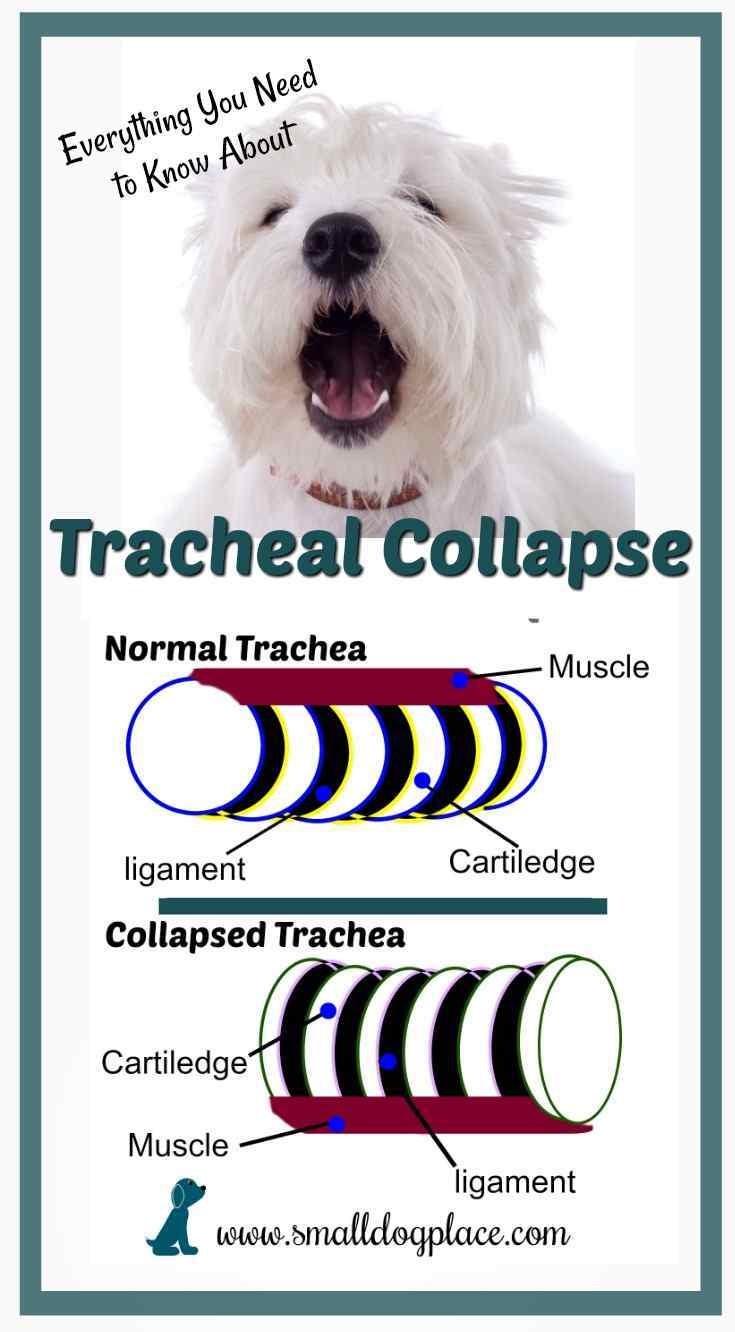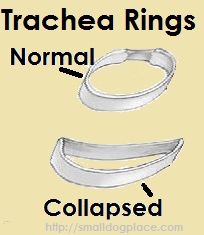Tracheal Collapse in Small Breed Dogs
 Small Dogs are Prone to Tracheal Collapse
Small Dogs are Prone to Tracheal CollapseTracheal collapse is a progressive
disease involving the trachea or windpipe most commonly seen in small breed
dogs.
The most common breeds afflicted
with this problem include Yorkies, Maltese, Toy Poodles, Pomeranian, Chihuahua,
Pug, and Shih Tzu, although it can occur in other breeds, as well.
Tracheal collapse should not be confused with
reverse sneezing. Reverse sneezing, also known as pharyngeal
gag reflex, is not really a cause for concern but often occurs as a result of a
mild irritation in the back of the throat such post nasal drip.
What is the Trachea ?
The trachea is a relatively rigid tube consisting of rings
made out of tough cartilage that resemble the letter C. The rings are not really a complete circle, but
are covered with a muscle at the opening of the C called the tracheal membrane.
The trachea or windpipe carries air (oxygen) into the lungs
when the dog inhales and expels air (carbon dioxide) from the lungs during an
exhale.
How does Tracheal Collapse Occur?
When the cartilage rings begin to weaken, the trachea loses its
C shape and the rings begin to flatten.
This flattening happens as the muscle or tracheal membrane gets floppy. As the dog inhales, air coming in causes the trachea
to balloon outward.
As the air leaves
the lungs, the windpipe flattens giving a tickling sensation that leads to coughing. If the flattening is severe, there will be an
obstructed airway causing distress to the dog.
The entire length of the trachea from the throat to the chest can be
collapsed, but more commonly, the collapse is in the area where the trachea passes
into the chest.
If the dog pants or becomes anxious, the problem worsens causing rapid breathing.
The rapid breathing causes the trachea to collapse further. As the collapse worsens, inflammation occurs in the trachea creating increased secretions, which cause more coughing.
More coughing creates more inflammation. And, well you can see that the process is a vicious circle.
It is a chronic problem and over time, the shape of the tracheal rings flattens and becomes misshaped, causing the condition to get worse and worse.

Causes of Tracheal Collapse
The cause of tracheal collapse is likely to have a genetic
component.
The cartilage of the tracheal rings in affected dogs is weaker than
in normal dogs or the rings do not form correctly making the rings more prone
to flattening into a U shape rather than a C shape.
Symptoms of Tracheal Collapse
If the problem is not severe, you might
not notice any symptoms. Perhaps
one of the first symptoms to surface in dogs with collapsing tracheal is a
cough that occurs after exercise or when he gets overly excited.
As the problem worsens, the dog will
have problems breathing during exercise.
He can tire easily and show signs of shortness of breath. The cough and other signs can be triggered by
excitement, fast eating or drinking, and hot and humid weather.
Coughing is common as the dog tries to
clear his airways, and the characteristic honking sound will resemble the sound
made by a goose.
In very severe cases,
the gums will look blue as breathing becomes more difficult. As mentioned
earlier, when this occurs, it is a medical emergency.
Symptoms usually begin in middle age by about the age of 6
or 7, but they can occur at any age.
Some dogs that have a collapsing trachea do not show signs until another
problem surfaces and compromises normal breathing. Some of the secondary issues that are associated
with this problem include:
- The dog becomes obese
- After surgery involving Anesthesia where an endo-tracheal
tube has been used - After a bout with kennel cough or other respiratory
infection - Exposure to environmental respiratory irritants such as
cigarette smoke, dust, etc. - The dog develops an enlarged heart where the heart
begins to press on the trachea
Diagnosis of Tracheal Collapse
The
veterinarian will diagnose the problem based on the symptoms and of the will
make use of X-ray to confirm the diagnosis.
More sophisticated techniques are
used such as Fluoroscopy, which is a moving X-ray. This method allows the vet to visualize the
dog’s trachea while the dog inhales and exhales.
Usually this technology is only available in
teaching hospitals. Another technique
is endoscopy which allows the vet to view the interior of the trachea. During this procedure, the dog is anesthetized,
and the vet can observe the inside of the trachea and take samples of tissue to
culture.
If the vet suspects the heart
is compromised, an echo-cardiogram can be done to evaluate cardiac function.
Treatment of Tracheal Collapse
Sometimes, treatment of any secondary
problems may alleviate some of the distress of tracheal collapse.
For example, if the dog loses weight or the
owner quits smoking around the dog, symptoms will lessen.
Removing other environmental pollutants such
as dust, mold and other indoor pollution helps.
HEPA-style air filters and vacuuming regularly also helps clear
up the air both for humans and dogs.
Sometimes treatment
with antibiotics to clear up respiratory tract infections helps.
Veterinarians often prescribe cough
suppressants.
Corticosteroids such as prednisone
given on a short term basis often help reduce the amount of mucus secretions.
Some vets will suggest Inhalers for dogs,
similar to those used in humans.
Sometimes
sedatives are used to help reduce the anxiety associated with difficulty
breathing.
Holistic veterinarians will also likely
recommend something that helps build cartilage.
Remember the rings that make up
the trachea is made of strong cartilage.
Some supplements that are often suggested include glucosamine,
chondroitin, MSM and cetyl myristoleate
If the dog is overweight, a strict diet
is usually highly recommended. Activity
should be restricted.
During walks, the dog should wear a harness rather than a
collar to take any pressure off of the trachea.
In severe cases, so little oxygen is
reaching the lungs that the dog’s mucous membranes (the gums in his mouth)
become blue, and the dog collapses.
This
is a medical emergency, and the dog needs to get to the emergency veterinary
hospital a.s.a.p.
The dog is often
tranquilized and given oxygen therapy along with cough suppressants.
Approximately 70% of dogs respond to
this medical management with good long term results.
Surgery is often recommended if the dog
does not respond to the medical management prescribed.
Several different procedures are currently
available, but owners usually must seek treatment options from a specialist.
One type of surgery involves inserting
a rigid prosthesis around the trachea which serves to create a trachea that
cannot collapse. There can be major
complications to this procedure.
Another less invasive technique
involves placing an expandable metal stent inside the trachea. This is done with an endoscope. There are side effects and risks associated
with this procedure as well, but it has shown to be very successful.
With any surgical procedure, medical
treatment continues.
Prevention of Tracheal Collapse
This is not an easy condition to
prevent, because there are no current genetic tests to perform on the
parents.
Often the disease does not
surface until middle age and at that point it is too late for any puppies born
to affected parents.
Does This Article Deserve Your Thumbs Up?
We always appreciate your support and encouragement. Your thumbs up means so much to us. Please like this article.
If you find this page or any page on Small Dog Place Helpful, or Useful in anyway, I’d love it if you would click the small heart found on the bottom right of each page.
You can also share or bookmark this page — just click on the:

Free Monthly Newsletter
Sign Up for Our Free Newsletter and get our Free Gift to You.
my E-book, The Top 10 Mistakes People Make When Choosing a Dog (and how to avoid them)





buy medicines online in india: indian pharmacy buy medicines online in india
prednisolone buy online uk